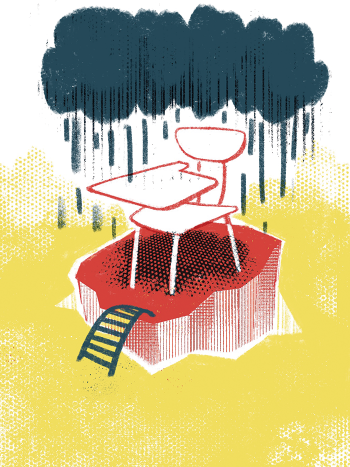It’s a moment most educators will recognize: A student has said something biased or promoted a stereotype. There’s a ripple through the classroom, but the speaker hasn’t noticed. Students look to you expectantly, and you know the statement can’t go unaddressed.
Most teachers look for opportunities to build a human rights culture and to counter hatred, bigotry, fear-mongering and intolerance. One way to do this, when students make a mistake, is to call them in rather than calling them out. Doing so prepares them for civic engagement by encouraging a sense of hope and possibility.
Guiding Instead of Dragging
In conversations and debates about social justice issues, insisting someone take responsibility when they say or do something hurtful—regardless of their intent—is a common way to protect vulnerable communities and individuals. It’s often necessary, but not every correction allows both parties to move forward. Calling out happens when we point out a mistake, not to address or rectify the damage, but instead to publicly shame the offender. In calling out, a person or group uses tactics like humiliation, shunning, scapegoating or gossip to dominate others.
In our society, call-outs have become a way of life. They are generally done publicly, either in person or online. Extreme calling out is when a person or a group expresses their disagreement cruelly, sometimes grandstanding. Fearing they may be considered politically backward if they don’t prove their “wokeness” on trending social justice issues, witnesses to the conflict may pile on while bystanders silently withdraw.
Calling in is a technique that does allow all parties to move forward. It’s a concept created by human-rights practitioners to challenge the toxicity of call-out culture. Calling in is speaking up without tearing down. A call-in can happen publicly or privately, but its key feature is that it’s done with love. Instead of shaming someone who’s made a mistake, we can patiently ask questions to explore what was going on and why the speaker chose their harmful language.
Call-ins are agreements between people who work together to consciously help each other expand their perspectives. They encourage us to recognize our requirements for growth, to admit our mistakes and to commit to doing better. Calling in cannot minimize harm and trauma already inflicted, but it can get to the root of why the injury occurred, and it can stop it from happening again.

Calling in is not for everyone or every circumstance. It’s not fair, for example, to insist that people hurt by cruel or careless language or actions be responsible for the personal growth of those who have injured them; calling in should not demand involuntary emotional labor.
Calling in is also not a useful response to those who intentionally violate standards of civil conversation. When powerful people use bigotry, fear and lies to attack others, calling out can be a valuable tool, either for the individuals they seek to oppress or for bystanders who choose to interrupt the encounter. When people knowingly use stereotypes or dehumanizing metaphors to describe human beings, their actions victimize targets and potentially set them up for violence. Calling out may be the best response to those who refuse to accept responsibility for the harm they encourage or who pretend they are only innocently using their right to free speech.
But, if call-ins can occur without demanding undue emotional labor or allowing space for hateful behavior, this approach offers a way forward that increases the potential for learning—particularly in activist and academic spaces. This practice works especially well when allies call one another in or when leaders, such as teachers, use it to model speaking up without losing the opportunity for learning. By teaching our students how to call one another in, we’re providing them the tools and skills they need to gather up those who share their privileges, to offer patience and grace when they can, and to facilitate growth—so others won’t have to.
It’s not fair to insist that people hurt by cruel or careless language or actions be responsible for the personal growth of those who have injured them.
Why Classrooms Are Made for Calling In
Teaching calling-in practices means teaching students techniques to avoid escalating conflicts and to relate to each other in affirming ways. When we teach call-in skills, we create what we need for ourselves and our students: brave spaces in which everyone understands that people make mistakes, that people come from diverse cultures and languages that may use words differently, and that people should not be punished for not knowing the right words to say. When we call students out instead of building a call-in culture in the classroom, we contribute to increasingly toxic and polarized conversations. And we make learning less inviting.
In class discussions, for example, the concept of privilege frequently becomes a source of call-outs, since privilege isn’t always apparent to those who have it. But educators can build space for a culture that relies on calling classmates in instead of publicly shaming them.
How to Start a Call-in Conversation
“I need to stop you there because something you just said is not accurate.”
“I’m having a reaction to that comment. Let’s go back for a minute.”
“Do you think you would say that if someone from that group was with us in the room?”
“There’s some history behind that expression you just used that you might not know about.”
“In this class, we hold each other accountable. So we need to talk about why that joke isn’t funny.”
In a classroom with a call-in culture, for example, a white student denying white privilege by pointing out how hard his parents worked is regarded first as a classmate who’s not understanding, not as a member of a privileged class refusing to acknowledge his advantages. The student’s statement offers an opportunity for peers to teach one another, for example, by asking if he has ever had the experience of being stopped by the police for no reason while walking down the street. This question—a form of calling in—encourages the student to rethink his position. It highlights the experience of the student rather than labeling him with an identity he’s not open to. Most importantly, it helps clarify a key misunderstanding by helping show the student that privilege doesn’t necessarily mean a lavish lifestyle, and that privilege and hard work aren’t mutually exclusive.
Calling in is not a guarantee that everyone will joyfully work together. It is simply the extension of grace, the opportunity to grow and to share learning and responsibility for each other.
Building a Call-In Culture
Calling someone in effectively requires preparation. The first step for educators is a self-assessment to prepare ourselves for effective engagements. This inventory might include writing and practicing some sentence starters, taking stock of which students tend to trigger or irritate us, and checking in with ourselves daily to assess the status of our emotional bandwidth.
While class discussions offer ample opportunities for calling students in, the technique shouldn’t just be reactive. There are many ways that educators can create a space where calling in is the norm, where students feel comfortable calling one another in and where they don’t shut down when they themselves are called in by their peers.
Practice Calling In
When someone is called in, they may still have the same reactions as if they were called out. They may feel panicked, ashamed, combative, upset or attacked. But letting students practice calling their peers in—and being called in—helps them see that mistakes can be an opportunity to learn something new and get a fresh perspective. When we let students practice calling in, we teach them how to distinguish between people who are intentionally hurtful and those who are trying to figure out how to understand or talk about differences.
One effective exercise I’ve used is “Human Rights in the Headlines.” Students bring copies of their local newspaper to class and are asked to select a story about something they believe is unfair. There will inevitably be differences of opinion about whatever is said, and these provide the opportunity for students to practice their call-in techniques. For example, questions such as, “I don’t think I understand what you’re saying, so can we talk some more?” or “Can we stop and explore what is happening now?” allow the asker to seek clarification and calm tensions.
Discuss Call-out Culture
One way to help students distinguish calling in from calling out is to ask what call-out culture looks like for them. You can also ask them to list and define specialized terms commonly used to justify call-outs like “trigger” or “microaggression.” Take time to discuss these terms. For example, you can explain that—despite how the word is casually used today—being “triggered” means being trapped in the memory of a past trauma, not just feeling uncomfortable. Ask students to consider the difference between aggressive behavior and a microaggression—both in terms of intent and impact. Explain that, if no one calls in an offender about a microaggression, they only have their own intentions to rely on going forward and will likely offend others. Talking about call-out culture before anyone is called in or out can help students understand why calling in is part of your classroom expectations.
You can continue this conversation by asking students to compare the effects of call-outs and call-ins. Calling out is intended to shame, encouraging others to exclude the person called out without any discussion of details that may shed light on what the conflict may actually be. Calling people out shuts down listening and escalates the conflict. Calling in prevents differences in understanding from escalating into conflict. It means exploring the underlying issues precipitating a situation. Given the difference in results, you may ask students to contemplate why so many people choose to participate in call-out culture.
Look for Curricular Spaces for Calling In White Students
In my college courses on white supremacy, I teach a concept called “appropriate whiteness” to discuss new forms of knowledge and history and to explore different ways whiteness may be lived. Appropriate whiteness occurs when white people can be proud of themselves and their ethnic backgrounds without falling into the trap of white supremacy (for example, neglecting a history of enslavement and oppression to pretend the Confederate flag is simply about heritage).
Calling in helps to dismantle a culture of white guilt and shame and helps transform fear into positive actions that center on the white community calling each other in. Helping white students talk about their race and explore their implicit biases aids them in learning how to complicate the concept of identity. It lets them practice participating in honest conversations without falling back on white fragility—or avoiding the topic of race altogether.
Learning about the ways in which they are privileged doesn’t need to be an exercise in guilt and shame for students. Learning to call one another in—and to respond to being called in with a sincere desire to do and be better—can help students feel good about committing themselves to a more just world and gives them another tool to build it.
Ross is a feminist human rights educator and visiting college professor. This article is a preview of her latest book, Calling In the Calling Out Culture: Detoxing Our Movement, which will be published by Routledge in 2019.
